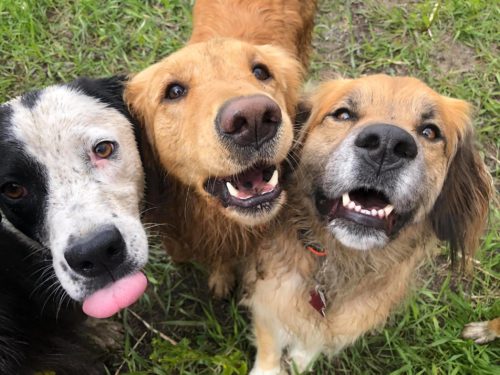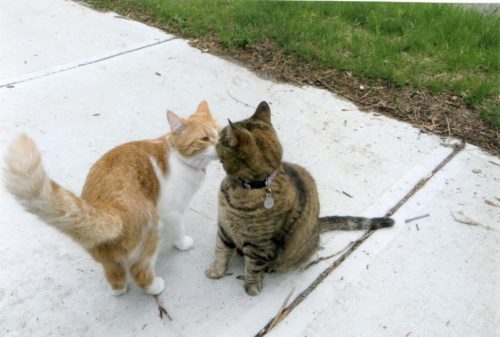A Few Words About Numbers

Count off! Photo: Rachel Bilodeau Ribis
Sometimes, I just want to know. How many pets are there in the United States? How many people have a pet? How many dogs are there? How many cats?
According to one source, in 2017-2018, 68% of American households kept at least one pet of some kind (from guppies to budgies to palominos), including 94.2 million cats and 89.7 million dogs. What’s more, the percentage of pet-owning households had climbed 12% since 1988.
But another source has a startlingly different set of numbers. During the same period, 56.8% of households had a pet, including 58.4 million cats and 76.8 million dogs. According to this organization, the percentage of pet-owning households had fluctuated slightly but remained pretty steady. That’s still a lot of pets, but dramatically fewer. The percentage of households varies by over 11%, and the difference in cats alone is a whopping 35.8 million.
So what’s going on? The truth is no one knows how many pets Americans own. Even the lower numbers are probably too high. It’s so easy to accept and believe numbers like these that I suspect we’re geared for it. Statistics seem like facts; their crisp certainty inspires confidence and feels satisfying. But actually these numbers offer a lesson in gullibility (mine, certainly) and critical thinking (the need for it).

Photo: Rachel Bilodeau Ribis
How can we get an accurate count of how many pet animals, and what kinds, live in American homes? Through sampling, of course, and then extrapolating, but I didn’t stop to think about the challenges involved. How can you ensure a close-to-representative sample and get accurate answers that then enable you to extrapolate with confidence? That’s a daunting task that calls for extensive surveying and demographic analysis. Who would do all this, and why? A pet census is hardly on par with the U.S. Census, with Congressional seats and federal funding at stake—though there are markets to assess and target, animal welfare planning to do, and public policies to be made.
The two sets of numbers I’ve used here come from the American Pet Products Association (APPA) and the American Veterinary Medical Association (AVMA). If you search online, these are the numbers that pop up. (For some quick side-by-side comparisons, see here.) Though I hesitate to lump them together, the APPA and the AVMA are both trade organizations. The APPA, which surveys 22,000 people every two years in the National Pet Owners Survey, assesses the market for products and services. And the AVMA, which surveys 41,000 people every five years for its U.S. Pet Ownership and Demographics Sourcebook, wants to know how many animals, and what kinds, need veterinary care.
Why such a disparity in their findings? The APPA may actually have a bias toward reporting high numbers to help foster national enthusiasm for pet-keeping, and that could lead them to err on the high side. Further, they may not need precise figures so much as a sense of the big picture and consumer trends. By contrast, the AVMA serves veterinarians and veterinary schools, which all need to plan. Does a suburban veterinary practice need to add a new vet with a specialty in chickens? Does a school expand its curriculum to include ferrets and other smallies? The AVMA may have a greater need for accuracy and, as professionals who weigh in on many issues about animal health, welfare, behavior, and policy, they may feel a greater sense of responsibility to the general public.

Photo: Rachel Bilodeau Ribis
In January 2019, Karin Brulliard and Scott Clement from The Washington Post took a critical look at these surveys and found their methods wanting. Both groups have switched to simpler online approaches that invite people to participate in their targeted surveys. Two things in particular may skew their numbers: the opt-in method and the special focus. Experts on polling worry that pet owners are more likely to choose to do a survey about pets than those who don’t own pets, and so boost the numbers, even if the organizations seek to adjust for demographics. In contrast, other methods are randomized and use mail, telephone, or in-person contacts to conduct surveys, and are considered more reliable. They’re also time-consuming and more expensive.
The U.S. Census Bureau conducts a comprehensive biennial American Housing Survey that covers everything from household demographics, to housing costs, to the physical condition of homes, to heating methods, to commuting habits. The samples are random and the surveys of 30,000 households are conducted in person. The methodology doesn’t get much better. Pets became part of this survey in 2013. The Bureau’s interest is not in the animals themselves but in the ability or willingness of people to evacuate in case of disasters. The 2013 survey found that 48% of households had pets, and this number rose only slightly, to 49%, in 2017.

So what does this all add up to? Pet-keeping is common but not as widespread as pet-lovers might think. It suggests that the numbers are high but not so dramatic after all, and remain pretty steady over time. When you’re calculating numbers in a nation of roughly 330 million, the differences between 49%, 56.8%, and 68% of households are significant.
All of this reminds me to stay on my critical toes. I’ve seen the numbers from the APPA used in articles, even scholarly ones, and well-researched books. Because of those citations, I used them, too. At this point, I’ve got to wince: I was ready to accept such high numbers in part because they corroborated my impressions that most Americans keep pets and that the number keeps growing. Confirmation bias, anyone? The fact that cats outnumbered dogs simply made me happy. (And about time, too!) When I encountered the lower numbers from the AVMA, and realized that the APPA numbers were probably inflated, I was inclined to accept them instead. The AVMA is a professional organization, after all. Again, I figured—without knowing anything about the methods behind the data—they must be solid. But even the AVMA’s numbers are adjusted estimates based on shaky methodology.
So back to my question. How many pets are there in the U.S? Millions. Probably, about half of American households have at least one.
As Brulliard and Clement report, another consumer research group, the Simmons National Consumer Study, conducts a more rigorous annual survey on a wide range of topics (and sells the data, so it doesn’t appear in a Google search). In 2018, they set the pet-owning household percentage at 53%, dogs at 77 million, and cats at 54 million—numbers that fall in the same range as the AVMA numbers. Nevertheless, their household figure of 53% is higher than the American Housing Survey’s 49%. So knock Simmons’s numbers down a few (million) notches, and we may have something like an answer—as long as we treat all the numbers as estimates, and even though the answer's not quite as satisfying.

Keep a nose out for numbers that confirm your biases! (Rory)
References (in the order of their first appearance):
“Pets by the Numbers.” Animal Sheltering Online, Spring 2020. Humane Society of the United States.
Karin Brulliard and Scott Clement. “How Many Americans Have Pets? An Investigation of Fuzzy Statistics.” The Washington Post, January 31, 2019.
